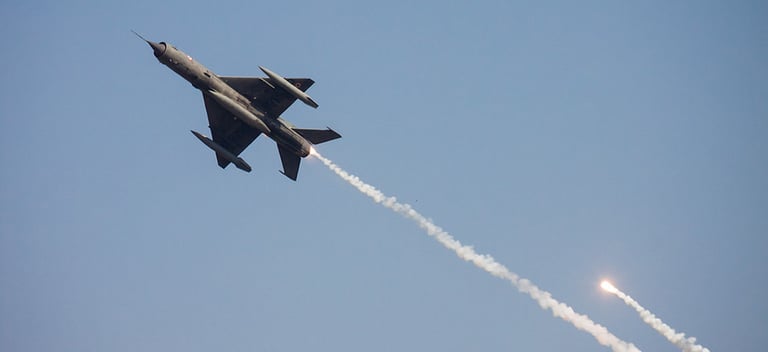The Indian experiment: How every IAF fighter aircraft is different from the "original"
By: Rishav
BLOGS
Introduction
The Indian airpower requirements in the region always focused on selecting a platform that is not just capable, but also compatible to operate under the "diverse" operational environments of the organization. The location of the country offers a unique opportunity to master the tactics in a variety of combat scenarios and adverse climatic conditions, from high temperature deserts in West to tropical forests in East; and from chilling high altitude tops in North to moisture filled airspace in South. The Indian armed forces have effectively framed the necessary strategies and productively pitched them into action whenever required in conflicts. One of the prime examples is Operation "Meghdoot" of 1984 where joint mission by Indian Army and Air Force allowed the state to gain control over the highest battleground on the globe, Siachen.
Now facing a lot more serious and greater threats, New Delhi has shifted its military doctrine to acquire technological advancements as well, instead of only the quantitative approach it adopted earlier. The move is simply a result of the evolving nature of warfare that is now in the era of "information warfare", with a military force having the strongest intel is destined to win any war or even a skirmish against the adversary. The one with the highest understanding of "where to fight" and "how to fight" can't be ruled out, easily understandable with the example where defences of professional forces like the Soviets were penetrated by resistance forces in Afghanistan, leading to so much causalities and damage that forced them to retreat.
Tradition of customized equipment: A Necessity
Purchasing customized variants of a system is not uniquely practiced by India, but in fact many states follow the procedure to suggest necessary changes related to equipment manufacturers, so as to make it compatible with their domestic conditions. When an aerospace company designs a weapon system, its priority remains that the given platform must be suitable to take the stress under the conditions imposed within origin country's national boundaries. This can be understood with the example of Light Combat Helicopter developed by India's state owned Hindustan Aeronautics Limited (HAL) Rotary Wing Research & Design Centre (RWR&DC). While the helicopter is capable of conducting the primary role of a attack chopper, that is to provide Close Air Support (CAS) and Strike, it is also a rotorcraft with world's highest service ceiling, officially 21, 300 feet. The main reason behind developing a system with such high altitude flying capability was India's operational conditions, one of which is already mentioned in the first paragraph: chilling high altitude tops in North.
While domestic programs and their characteristics are flexible and changed according to primary user's evolving situations, imported products does not offer such luxury and many compromises are made during negotiations. However, basic changes or customization are indeed available to the customer who may suggest necessary modifications to acquire the desired weapon with some sort of unique attributes. Indian military already has enough experience while buying customized weaponry. Today, we list out the basic changes that are exclusively found on combat aircrafts of Indian Air Force and not on international or original counterparts.
1. Dassault Rafale F3R(I)
The acquisition of Rafale is probably the most dramatic aircraft acquisition ever occured in history of military import deals. The programme had to go through multiple critical analysis as well as deep through investigations. However, at the end, the weapon finally received by Indian Air Force turned out to be top-notch and unchallenged by any adversary in the region. The Rafale F3R, an up-to-date standard of 4.5 generation fighter aircraft from a leading French aerospace giant, is more than what needs to be called a "gamechanger" for the power balance in the region.
Designed to undertake omnirole operations, Rafale covers a dynamic range of combat missions in a single sortie. Depending on priority, the platform can deliver air superiority with load of long range air to air missiles, or suppress the hostile forces on ground with munitions tucked underwing, or intercept surface-to-air threats with its integrated full-package electronic warfare suite SPECTRA; specialise in one or choose all the possibilities, this French "beauty as well as beast" is one stop solution to fulfill all your demands. However, while the default unit is already a very versatile system, IAF still managed to convince the suppliers to turn the aircraft into a "unique" variant.
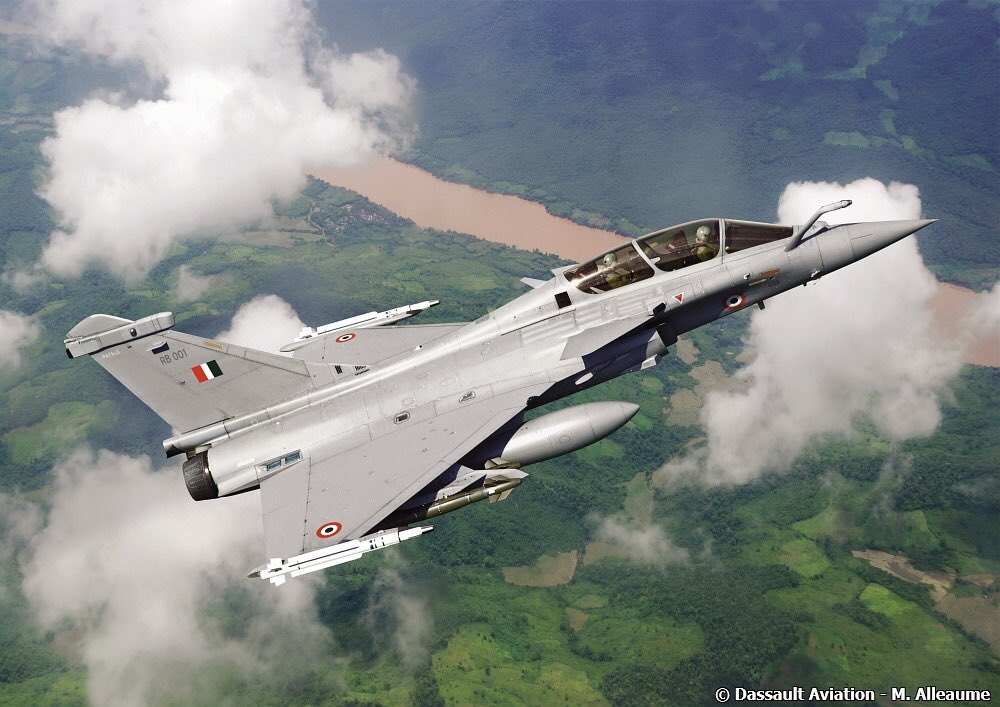

Radar
While the full Transfer of Technology (ToT) couldn't be achieved, one of the clauses signed under the 2016 deal was to share some of the technical know-how with Indian companies and within which state owned Bharat Electronics Limited (BEL) was contracted to supply Transmit/Receive (T/R) modules for Thales RBE-2AA Active Electronically Scanned Array (AESA) radar destined for Indian Rafale batches. This, though a little, gives a small proportion of indigenous content in one of the most important components of the modern combat aircraft, that is the radar.
Electronic Warfare Suite
The Electronic Warfare system in the Rafale EH/DH reportedly features multiple additions in the standard variant already in service. The Indian Air Force will utilize a low band jammer, that is sufficient to counter a variety of threats, protecting itself or even a whole formation in-flight. With 1-4.5 gHz bandwidth, the system can jam surface-to-air threats including surveillance and tracking radars, preventing the hostile to acquire early warning about the offensive action.
The aircraft will also witness integration of X-Guard fiber active towed decoy system, a premium EW equipment developed by Israeli firm Rafael. Equipped on one of the underwing pylons, the towed decoy system can be deployed in hostile environment crawling with threats as it lures the incoming enemy missiles by employing "deception" tactic, that is to create false targets on which the seeker is force to lock on and eventually miss the "actual target".
Aiding systems
India reportedly contracted Elbit systems of Israel to provide Display And Sight Helmets (DASH) for Rafale aircraft. DASH is proven Helmet Mounted Display and Sight (HMDS) that is highly potent in providing solutions for acquisition, data processing, identification and targeting of hostile assets in all weather scenarios while also giving full control on achieving full operational capability of armaments, including air-to-air missiles with High Off BoreSight (HOBS) firing solutions.
There will be an improved InfraRed Search and Track (IRST) system. Instead of having a single system for the purpose, Rafale is embedded with two primary components to gain the desired ability. With range upto 100 kilometers, the Forward Looking InfraRed (FLIR) provides regular output for pilot about the target's signature while another TV/IR sensor is used for identification upto 40 km range.
2. Dassault Mirage 2000I
If there is any fighter aircraft that is trusted the most after MiG-21, it is none other than the Mirage 2000. Designed by the same industry that today produces state-of-the-art Rafale aircraft, Mirage 2000 is the final member of the legacy Mirage family that saw immense success while serving with various organisations in various parts of the world. It's potent firepower was utilised on multiple occasions to complete the desired objectives. Mirage 2000 is more or less a "go-to" platform for Indian Air Force for the reason that whether it was about bombing the enemy fortifications in 1999 and 2002, conducting airstrikes against militant hideouts while penetrating deep inside hostile airspace in 2019 or guarding the airspace since it's induction in 80s, Mirage never turned out to be any kind of liability but in fact, a unmatched rival for the foes.
However, the aircraft active today is completely dominant over the one that arrived in the 80s for the reason that Mid Life Upgradation (MLU) signed in 2011 significantly improved the overall offensive and defensive capability of the platform. While previously it was easy to visually differentiate between upgraded and un-upgraded Mirages by looking at the nose cone, where black indicates H variant and I, all the aircraft now feature grey nose due to new pulse doppler radars. Even today, legacy and wrath of Mirage continues. Here we look at how good the new Mirage 2000"I" is in terms of its onboard capability.
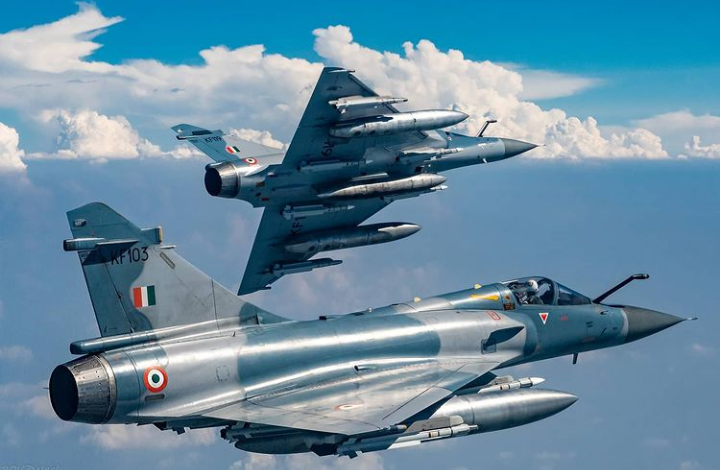

Aiding systems
Israeli weapon systems are also in operational service with the Mirage fleet, alongside the original French offensive package. The state-of-the-art precision guided munitions like SPICE 2000 or Laser Guided Bombs like Griffin are consistently employed, replacing the original Paveway LGB. Interestingly, IAF also utilize Russian made missiles onboard the aircraft that is one of the most unique feature of the aircraft. The R-73E "Archer" was integrated after the obsolete Matra R.550 "Magic II" short range heat seeking missiles were phased out and no western substitute was available. The MBDA MICA family was not compatible with old mission computers and radar of un-upgraded Mirage 2000H fighter of late 80s era. Therefore, the weapon already in bulk has been pitched into service today.
3. Sukhoi Su-30MKI
Inducted in 2002, the heavyweight twin engine aircraft from Russia's Sukhoi aerospace is still India's most trusted combat aircraft. With 260+ units available to dispatch at any point of time and anywhere in India, the Su-30MKI is undoubtedly "the first line of defence" for Indian Air Force that safeguard the airspace 24x7 against adversaries. The aircraft was adopted only after successful operationalization of Su-30K aircrafts, which were generally regarded as twin seat Su-27, as they provided first hand experience to Indian Air Force for operating the Flanker family, one of the most highly maneuverable if not the most maneuverable jet fighter. Operating such complex but potent machinery was not an easy task and it was necessary to have full fledged knowledge about the platform's requirements in parallel to adapt it according to India's own operational conditions.

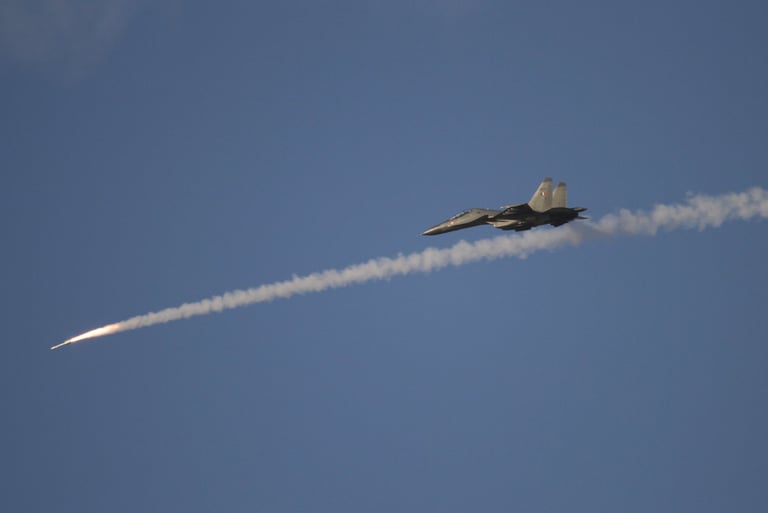
The Su-30MKI origin can be traced with a case of "hybrid", where the Su-27's already high agility was enhanced with integration of Thrust Vector Control (TVC) engines and addition of canards to the airframe, inspired from Su-37, a technology demonstrator based on characteristics required for Su-35 development. The success of the experiment allowed Indian Air Force to become the first organization to receive such a high end platform. Today, many matured and successful Flanker variants are based on Su-30MKI airframe, that is of twin seat configuration with canards. Even Russian Air Force and Russian Navy are highly impressed with aircraft's reliability to conduct multirole operations and already tested this capability in war torn regions.
The latest combat use of Su-30MKI was occurred during two day skirmish of 2019, when multiple formation of the aircraft were employed on air superiority as well as decoy roles to assure the safety of air and groun assets of Indian armed forces. Nearly two decades of operations with the platform, the Indian Air Force has managed to modify the complexity of this aircraft on their own with local solutions in hand, while also planning on major upgradation of the aircraft coming in few years. Here we look at present status of Su-30MKI and how it differs from early Flankers ( Soviet-era Su-27 and Su-27UB/30) as well as other export version of flankers produced
Role
While Su-30MKI indeed retains the legacy "air dominance role" of the traditional Flanker family, the tandem twin seat configuration actually allows it to conduct strike operations more precisely, with workload shared with an additional officer, who can be either termed as Weapon Systems Officer (WSO), Navigator, Radar Intercept Officer (RIO), or simply Guy In Back Seat (GIBS). He is generally responsible for targeting, communication systems, data-links with communication relays and armaments onboard the aircraft. However, it must be noted that air-to-air weapons are triggered by the front pilot himself, while the GIBS further enhances the situational awareness while also improving the overall precision with the offensive weapon package.
Avionics and EW suite
The Su-30 programme, focused on acquiring best available platforms from around the globe, saw diversity in it's avionics suite. Multi Functional Display is supplied by Israel based firm, Elbit (EL-Op). The initial batches were integrated with Multi-Functional Displays (MFDs) but today, all units are equipped with indigenous MFDs manufactured by Samtel avionics, a New Delhi based defence firm. Multiple components of Russian EW suite are replaced by Indian origin alternatives. The DRDO DARE Tarang Radar Warning Receiver (RWR) has been integrated, replacing Russian SPO-15 "Beryoza" that was present in Su-27 models. The later export models of Su-30: Su-30MKA, Su-30MKM, etc., features RWS-50 RWR, manufactured by SAAB. The aircraft also allows integration of Israeli Elta ELL-8222 Wide Band Jammer, that is designed to intercept and neutralize air-to-air and surface-to-air missile threats, and effectively act as a self defence equipment. Due to lack of embedded Missile Approach Warning System (MAWS), a pod based system is also in process of integration, developed by DRDO to identify multiple missile types locked on the aircraft and provide early warning to pilot in order to release effective countermeasures.
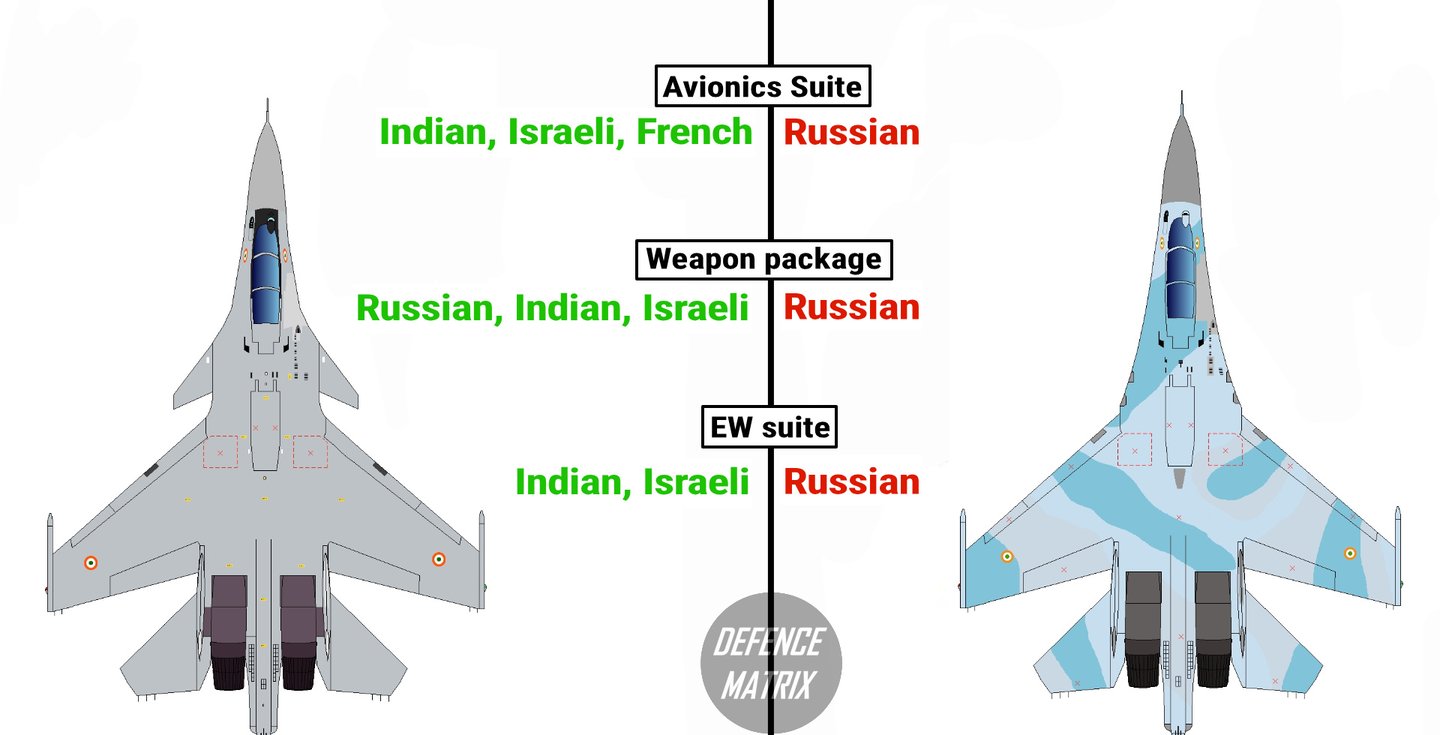

Weapon package
While the initial service period saw IAF using the standard Russian weapons package, the recent developments now showcase a more flexible inventory of munitions, for both air-to-air and air-to-surface engagements. Indigenous solutions like Successful integration of Astra Active Radar Homing (ARH) Medium Range Air-to-Air Missile (MRAAM), a counterpart of obsolete R-77; BrahMos, a Mach 3 capable Air Launched Cruise Missile (ALCM) that can target ground based installations within 400 kilometre range, High Speed Low Drag (HSLD) Precision Guided Bombs (PGMs) to complement Russian alternatives, as well as Israeli solutions like Derby-I ER MRAAM, Griffin Laser Guided Bomb (LGB) and SPICE 2000 PGM, are some examples of exclusive nature of armament package with the aircraft. Manu programmes are also in progress, including next generation variants of Astra, Anti-Radiation Missile (ARM) Rudram-1 and more.
If there is any other Flanker variant that comes close to Su-30MKI when it comes to integrating equipment from around the world on large scale, it is none other than Malaysia specific Su-30MKM, that carries systems from Russia and France, and weapon systems from Russia, China, France and surprisingly American as well.
4. MiG-29UPG
Induction of MiG-29 in IAF was not just about enhancing the fleet, but also bringing the required edge over the adversaries in the region. India was the first forein state to formally order the twin engine aircraft produced by Mikoyan Gurevich during the Soviet regime. When it arrived, it was nothing less than a revolution as the technologies obtained with it were top notch at that time. First hand experience on Helmet Mounted Sights (HMS) and a proper Beyond Visual Range (BVR) missile was obtained with the Fulcrum and only later with other aircraft. Therefore, whether it was about engaging targets from standoff range or going into tight turn phase during dogfights, MiG-29 was a lethal weapon that adversaries had to think twice before messing with.


Electronic Warfare Suite
One of the most distinctive features of the aircraft. The DRDO D-29 EW includes a combination of RWR, Electronic Counter Measures (ECM) and Electronic Support Measures (ESM) components designed to identify and neutralize threats in flight. The indigenous Tarang Mk II Radar Warning Receiver (RWR) is employed to track sources of Radio Frequency (RF) illumination to offer situational awareness to the pilot. The integrated Digital Radio Frequency Memory (DRFM) based Italian Elettronica ELT-568 Self Protection Jammer (SPJ) allows jamming of Ku-band seeker of incoming radar guided missiles, safeguarding the aircraft in combat missions.
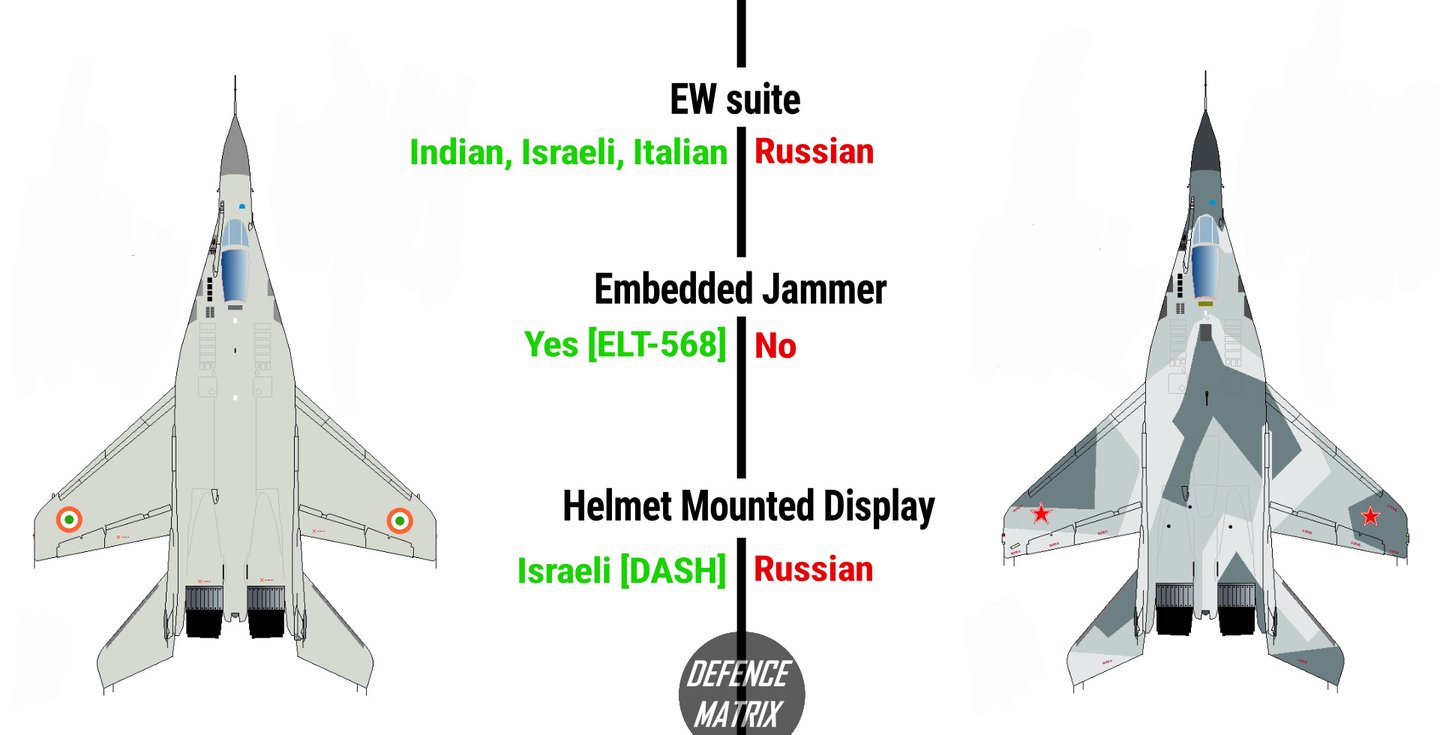

Aiding System
The MiG-29UPG is also equipped with Display And Sight Helmet (DASH), replacing the vintage Shchel 3UM HMS. With new HMDS, the aircraft can now enhance its angle of fire in close combat, utilising the R-73E "Archer" firing envelope Off BoreSight.
5. MiG-21 "Bison"
It was there in the air since the very first Indo-Pak war of 1965 and even today, stay alert on forward airbases and launched as "first response" against any hostile attempt to penetrate the friendly airspace. With nearly 60 years of experience on operating and maintaining the large fleet with local solutions, the Indian Air Force control on the platform is surely commendable while also a liability to some extent due to obsolete technology. However, it's current state is completely different from the original version and even better than standards produced by mainland China F-7 that is much newer.
Based on MiG-21-93, the Bison is extensively modified MiG-21Bis and also sometimes referred to as MiG-21Bis UPG. It introduced much needed enhancements in 3rd generation aircraft to fit with 4th generation standards including Beyond Visual Range (BVR) capability and more. In short, it's not the same old "Fishbed" of the Cold War era.

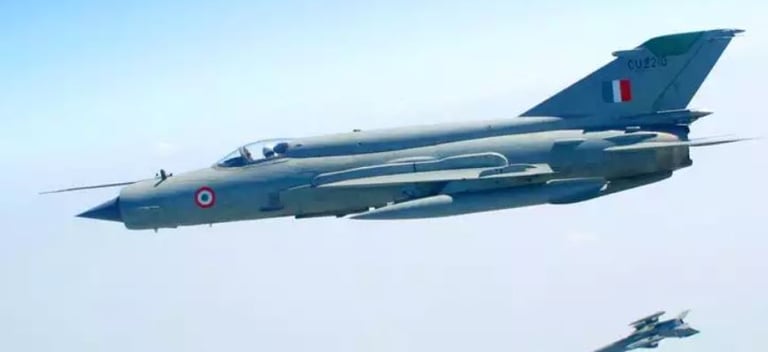
Aiding Systems
The MiG-21 Bison is equipped with Sura-K Helmet Mounted Sight (HMS) instead of standard aircrew helmet. The same HMS is in service with Su-20MKI. The system is cued with weapons onbord the aircraft and covers a wide range of targeting solutions for the operator to utilize them properly in air combat. The same HMS was operational with Wg Cdr Abhinandan Varthaman on 27 February 2019 when he was chasing a Pakistan Air Force F-16 before shooting it down using his R-73E heat seeking missile.
Beyond Visual Range capability
With Kopyo-M radar compatible to link up with medium range missiles like R-77, the aircraft can now engage targets at Beyond Visual Range(BVR) unlike the previous models where radars installed were only for detection purposes at short ranges and only heat seeking close combat missiles (CCMs) like R-60 and R-73 were supposed to be used in combat.
Jammers
This is one of the most power multiplying capabilities of the platform that significantly enhances it's survivability. The ELT-8222 jammer installed one one of the aircraft's external hardpoints can provide full fledged protection during combat missions and ensures safety of the particular aircraft or a two ship formation in-flight.
6. Jaguar
Purchased in 1978, the 40 year old Jaguar from Anglo-French aerospace firm SEPECAT still forms a vital element for Indian Air Force strike package. The first batch to enter limited service were originally Royal Air Force airframes of Jaguar GR.1 and T.2, but soon the India specific variants of Jaguar IS, IB and IM were introduced in service, both imported and license produced (by HAL) airframes. The stock IS units were soon witness to local upgrade package DARIN (Display Attack Ranging Inertial Navigation) that was supposed to improve the aircraft's reliability and further enhance the precision, aided by formidable navigation, attack and guidance systems.
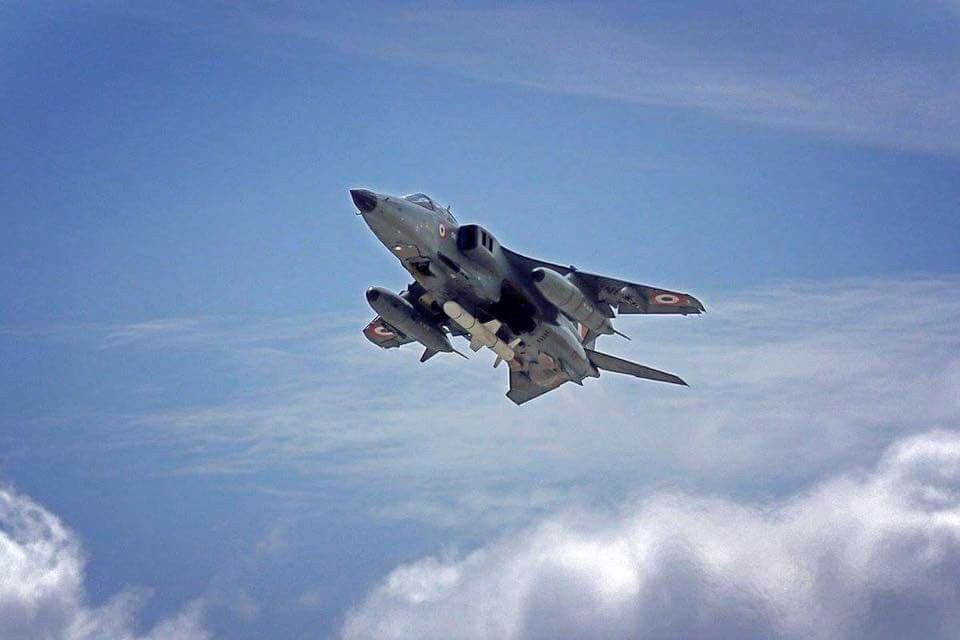

Today, even after being the only operator of the type, Indian Air Force has managed to keep the aircraft in worthy condition to act as suitable Deep Penetration Strike Aircraft (DPSA) with a diverse weapon package designed to annihilate the enemy strategic assets. The present DARIN standard is at third stage with major modern systems already integrated and successfully operationalized with the fleet. Following are the attributes which make IAF Jaguars not just different but even better than any variant ever produced:
Radar
The Jaguar IM was the first variant to have an integrated radar. The Thomson-CSF Agave radar was optimised to provide air-to-sea detection and tracking capability to the platform.The latest Jaguar IS DARIN III sports an AESA radar, that is in fact first platform in the total fleet to have fully operational AESAR. The Elta EL/M-2052 offers the capability to track airborne targets upto 200 kilometres and surface targets upto 290 kilometres. Previously in DARIN I and DARIN II, a Laser Rangefinder and Marked Target Seeker (LRMTS) system from French Thomson-CSF/Thales was fitted in the nose, replacing the original ones from Ferranti.
Weapon package
The new Jaguars are completely capable of carrying Precision Guided Munitions and smart bombs designed to hit hostile armoured brigades, fortifications as well as maritime assets. The indigenous Smart Anti Airfield Weapon (SAAW), American CBU-105 sensor fusion smart bomb and Harpoon Block 3 Anti Ship Missile, Israeli Griffin Laser Guided Bomb are some significant names. For self defence, the old heat seeking Matra Magic II is replaced by the MBDA AIM-132 Advanced Short Range Air-to-Air Missile (ASRAAM), that is a lethal weapon for close combat due to Imaging InfraRed (IIR) seeker head with High Off BoreSight (HOBS) ability, making it highly agile against airborne aircraft in tight turning fights.

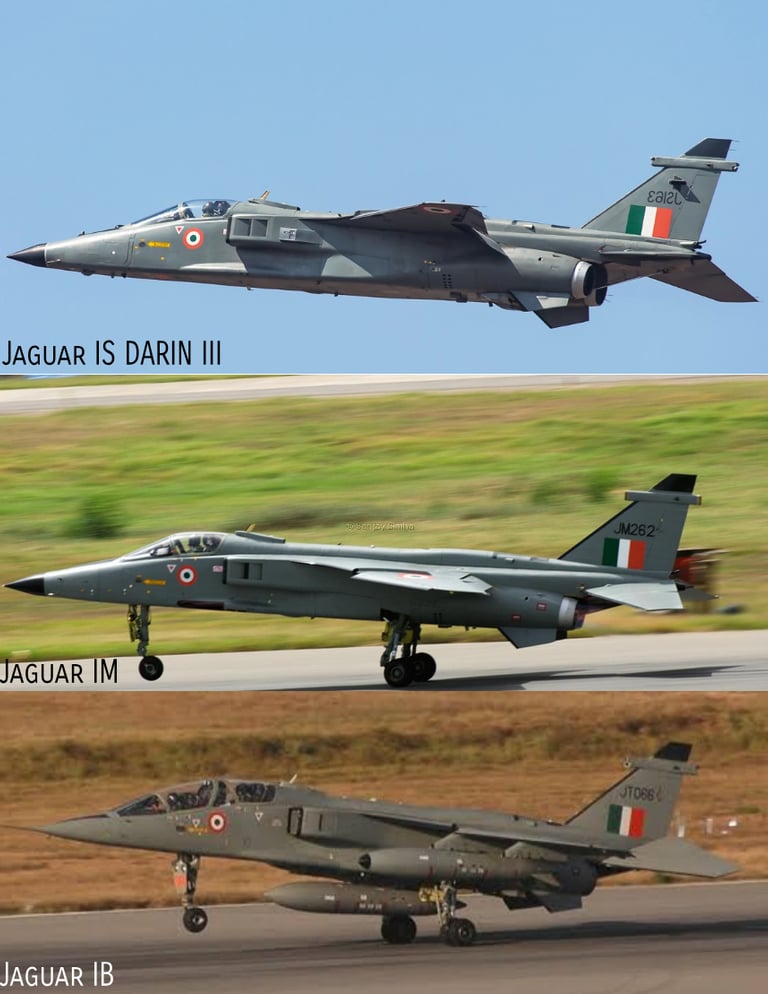
Aiding System
The aircraft is equipped with Rafael LITENING targeting and RecceLite reconnaissance pod. Integration work is also in process for Display And Sight Helmet (DASH) to considerably improve the operator's situational awareness and fully utilize ASRAAM's combat ability.
Bonus: Hawk-I
Still in experimental stage, the Hawk-I still shouldn't be ignored while making this list for the reason that this indigenous modification on British trainer aircraft is also a unique example, that already own the impression of an effective low-cost solution for Light Combat Aircraft (LCA). While original BAe Hawk Mk.132 was already compatible to carry rocket pods and other air to ground attack weapons like rocket pods, the Hawk-I development now offers additional ability to use precision guided munitions, as well as state-of-the-art ASRAAM IIR CCM that assures the self defence of the aircraft in combat sorties. The primary role of this aircraft will be Close Air Support (CAS), to wreck havoc on hostile assets on ground and provide protective overwatch on friendly units.
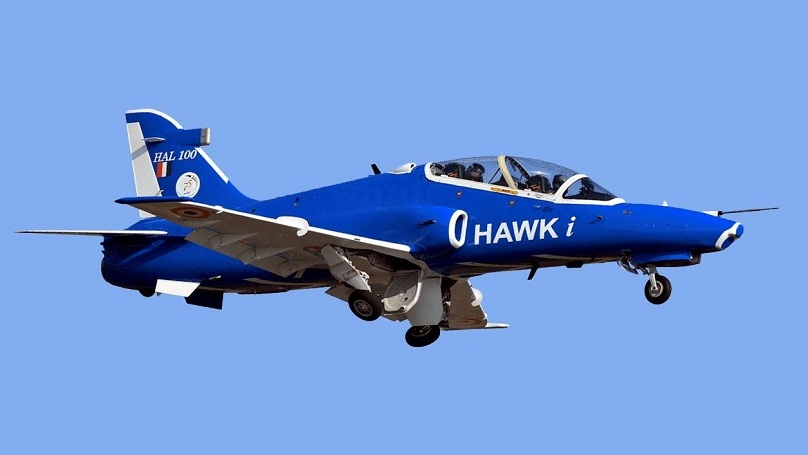

However, fact cannot be ignored that it's actual capability can only be employed when it is deployed on active service and not prototype stage.
DASH: "Looks that Kill"
In this whole article you probably read a lot of mentioning about Display And Sight Helmet (DASH). With large scale adoption, it is indeed clear that the particular system is standard issue Helmet Mounted Display solution for Indian Air Force. Designed by Israel based firm, Elbit Systems Ltd., DASH enables the pilot to "paint" their targets and aim/arm/fire their weapons simply by looking at the prey. It enhance the capabilities of Night Flying with Night Vision, that provides Colour Day & Night Display, 3D symbology, Head Tracking, Sensors & Weapon Cuing. It measures the pilot’s Line-of-Sight (LOS) relative to the aircraft, and transfers its information to other aircraft systems proving full-fledged situational awareness.
DASH is closely integrated with the aircraft's weapon system, via a MIL-STD-1553B bus. (Here, Bus means a communication system that transfers data between components inside a computer, or between computers). Aircraft, sensors, avionics and weapons are thus enslaved to the target. It brings displays to the pilot’s eye-level and informs the pilot of target location, and system inputs while offering all modes of operation with Hands On Throttle And Stick (HOTAS) controls. HMDS is most common system for combat aircraft categorized under fourth generation.
Elbit Systems' manufactured and supplied the DASH family of HMD/S to various countries. It is not exclusively compatible for western fighter aircraft but completely adaptable to various other fighter/attack aircraft and will accommodate advanced missiles and smart weapon lock-on envelopes. The latest DASH IV and V are operational with multiple aircraft types in Indian Air Force, that are Tejas Mk1, Mirage 2000-I, Rafale F3R(I), MiG-29UPG as well as Jaguar. The heavyweight frontline fighter, Sukhoi Su-30MKI is also in process to integrate Israeli HMDS, in order to replace the obsolete Sura-K HMS.

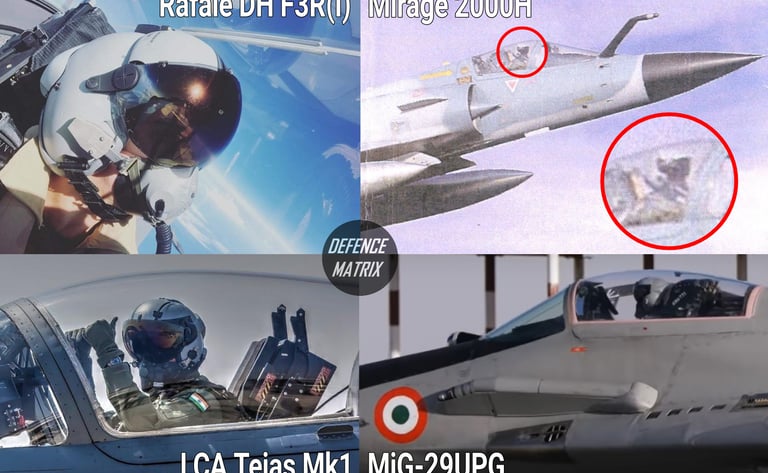
Conclusion
It is already mentioned that IAF is not the only organization to use customized systems. However, few attributes of the fighter fleet in service makes them not just different but even better than their "siblings". Said enough, the Indian Air Force has always trusted their procured systems and was able to fulfill their demands even with local solutions established due to long exposure with the platform, both in combat as well as in peacetime. Some of the remarkable operations of the past were carried out by employing such "never used before" tactics. This would not be possible without trust by the operator and choice to go beyond the limits. Therefore, whether it's about going supersonic over the enemy's capital or bombing his bunkers located on high altitudes, New Delhi has always proven its superiority attained in unexpected circumstances.

